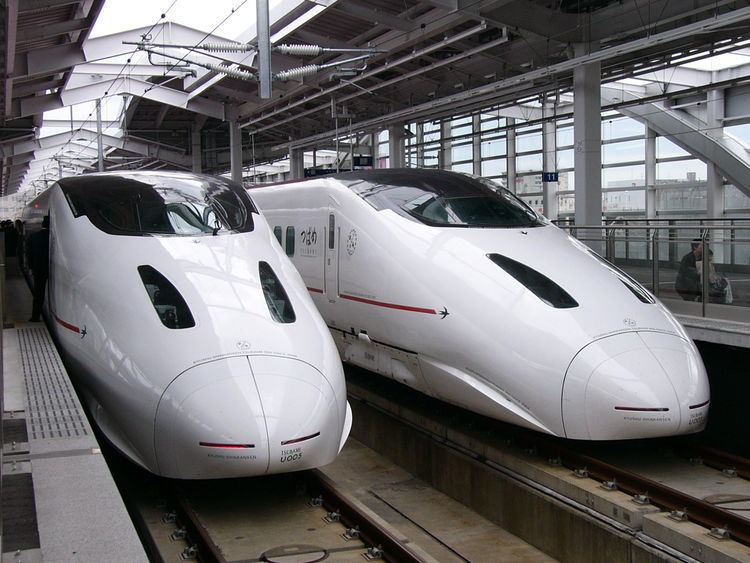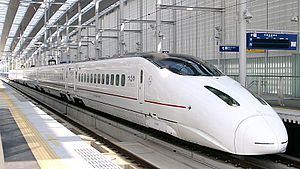Native name 九州新幹線 Opened 2004 Line length 256.8 km (159.6 mi) | Depot(s) KumamotoSendai Stations 12 | |
 | ||
Rolling stock 800 seriesN700-7000/8000 series Operators Kyushu Railway Company, West Japan Railway Company | ||
Cm of the kyushu shinkansen
The Kyushu Shinkansen (九州新幹線, Kyūshū Shinkansen) is a Japanese high-speed railway line between the Japanese cities of Fukuoka (Hakata) and Kagoshima in Kyushu (and an extension of the Sanyo Shinkansen from Honshu), running parallel to the existing Kagoshima Main Line and operated by the Kyushu Railway Company (JR Kyushu). The southern 127 km (79 mi) was constructed first because the equivalent section of the former Kagoshima Main Line is single track, and thus a significant improvement in transit time was gained when this (dual track) section opened on 13 March 2004, despite the need for passengers to change to a Relay Tsubame narrow gauge train at Shin-Yatsushiro for the remainder of the journey to Hakata. The northern 130 km (81 mi) section opened on 12 March 2011 (although opening ceremonies were canceled due to the 2011 Tōhoku earthquake and tsunami), enabling through-services to Shin-Osaka (and with a change of train, Tokyo).
Contents
- Cm of the kyushu shinkansen
- Train simulator kyushu shinkansen intro 2 routes gameplay ps2 hd
- Kagoshima Route
- 2016 Kumamoto earthquakes
- Nagasaki West Kyushu Route
- Other planned routes
- Station list
- Services
- References

The construction of the first section (from Takeo-Onsen to Isahaya) of the West Kyushu Shinkansen route to Nagasaki, approximately 45.7 km (28.4 mi) in length, began in 2008, with construction of the 21 km (13 mi) section from Isahaya to Nagasaki commencing in 2012. The entire line is due to open by March 2023,. Service was proposed to be provided by Gauge Change Train (GCT) trainsets (which are designed to operate on both existing narrow gauge lines and standard gauge Shinkansen lines); however, technical issues with the bogies is likely to delay CGT introduction until 2025, and initial service options are now being investigated, such as a 'relay' service.

Train simulator kyushu shinkansen intro 2 routes gameplay ps2 hd
Kagoshima Route

Construction of the Kagoshima Route (鹿児島ルート) began in 1991, and the first segment between Kagoshima and Shin-Yatsushiro opened on 13 March 2004. This initial section cut travel times between the two cities from 130 minutes to 35 minutes, and reduced the time between Hakata and Kagoshima from 4 hours to 2 hours. When the entire line was completed, the travel time from Hakata to Kagoshima was further reduced to about an hour and 20 minutes. Like all Shinkansen lines, the Kyushu Shinkansen is standard gauge.
The line's Sakura and Mizuho services operate through to Shin-Osaka Station via the Sanyō Shinkansen.

In September 2011, six months after the line's completion, JR Kyushu reported a year-over-year increase in ridership of 64 percent to the southern part of Kyushu (between Kumamoto and Kagoshima), easily surpassing the 40 percent increase projected by the company. By the one-year anniversary, ridership had increased, mainly from tourists from Kansai and Chugoku. However, in northern Kyushu, where there is fierce competition with conventional JR rapid service, the private Nishi-Nippon Railroad, and expressway buses, Shinkansen ridership increased by only 38 percent (compared to the now-discontinued conventional express Relay Tsubame), falling short of estimates.
2016 Kumamoto earthquakes

On the evening of 14 April 2016, the entire length of the Kagoshima Route was shut down after the first of two powerful earthquakes struck Kumamoto prefecture. There was extensive damage along the route, including cracks in elevated support structures at 25 locations and collapsed sound insulation walls at around 80 locations.
A Series 800 consist that was deadheading derailed near Kumamoto Station after the first tremor. On 18 April, JR Kyushu began attempts to return the derailed train to the tracks.
On 27 April the line reopened with reduced speed and service frequency.
Nagasaki (West Kyushu) Route
A Shinkansen line from Fukuoka to Nagasaki, initially known as the Nagasaki Shinkansen (長崎新幹線), was laid out in the 1973 Basic Plan. Renamed as the Nagasaki Route (長崎ルート), then changed to the West Kyushu Route (西九州ルート, Nishi Kyūshū rūto) in 1995, the planning of the line had been slowed down by concerns over the necessity of duplicating the existing narrow-gauge Nagasaki Main Line and Sasebo Line between Shin-Tosu and Takeo-Onsen, and local opposition over the final section in Nagasaki city.
The current plan is to continue using the existing narrow gauge track from Shin-Tosu to Takeo-Onsen (including duplicating the 12.8 km (8.0 mi) Hizen Yamaguchi to Takeo-Onsen section) and build a new Shinkansen line from Takeo-Onsen to Nagasaki. Initially proposed to be operated by Gauge Change Trains (GCT) from opening, technical issues with the development of the GCT has required consideration of other options. The GCT was expected to allow a travel time of around 1 hour 12 minutes between the two cities, versus 1 hour 45 minutes currently, however with its introduction now delayed until at least 2025, options such as "relay" services are being considered. If the entire route was constructed to Shinkansen standard, travel time would be 41 minutes.
Construction of the first 45.7 km (28.4 mi) segment between Takeo-Onsen and Isahaya began on 28 April 2008. Debate over the final section between Isahaya and Nagasaki continued for several years, before construction was finally approved by the government in December 2011. The scheduled completion date is 2023.
Other planned routes
According to the Shinkansen Basic Plan laid out in 1973, the Kagoshima and West Kyushu (Nagasaki) routes would be accompanied by two other routes: the East Kyushu Shinkansen, from Hakata to Kagoshima-chūō via Ōita and Miyazaki, paralleling the Nippō Main Line; and the Trans-Kyushu Shinkansen, linking Kumamoto and Ōita, and connecting with the also-planned Shikoku Shinkansen to Matsuyama, Takamatsu and Osaka. These plans have been shelved indefinitely, and are unlikely to be reconsidered until the completion of Shinkansen lines already under construction.
Station list
Tsubame trains stop at all stations. For Mizuho and Sakura, all trains stop at stations marked "●", while some trains stop at those marked "△".
Services
Services are operated by 6-car 800 Series sets, with a maximum speed of 260 kilometres per hour (160 mph). The trains were developed by Hitachi, and based on the 700 series trains already in service on the Tokaido/Sanyo Shinkansen line.
Individual trains are named Tsubame ("Swallow"), the name of the former Hakata-Kagoshima limited express service. 8-car N700-7000 and N700-8000 series trains are used on through-running services between Shin-Osaka and Kagoshima-Chūō. The first set (S1) was delivered to Hakata Depot in October 2008.
Three services operate on the line, in order of speed: Mizuho, Sakura, and Tsubame. The Mizuho makes two return trips between Shin-Osaka and Kagoshima-Chūō during the morning hours, and two return trips during the evening, with an end-to-end journey time of 3 hours 45 minutes. Sakura services run once per hour throughout the day between Shin-Osaka and Kagoshima-Chūō making additional stops, with an end-to-end travel time of 4 hours 10 minutes. There are also one to two Sakura services every hour between Hakata and either Kumamoto or Kagoshima-Chūō. Tsubame trains operate the all-stations service between Hakata and Kumamoto 1-2 times per hour, with some services operating to/from Kagoshima-Chūō.
